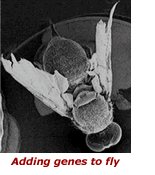Last updated: April 26, 2013
1981-82: First Transgenic Mice and Fruit Flies
1981-82: First Transgenic Mice and Fruit Flies
 Scientists had been able to add new genes to bacterial cells for several years. In the early 1980s, they figured out how to add stably-inherited new genes to animals. The first such "transgenic animals" were mice and fruit flies. By adding foreign genes or genes spelled slightly differently than normal, scientists had a new way to test the functions of genes.
Scientists had been able to add new genes to bacterial cells for several years. In the early 1980s, they figured out how to add stably-inherited new genes to animals. The first such "transgenic animals" were mice and fruit flies. By adding foreign genes or genes spelled slightly differently than normal, scientists had a new way to test the functions of genes.
More Information
References for Adding Genes to Mice:
Costantini F., Lacy E. Introduction of a rabbit beta-globin gene into the mouse germ line. Nature, 294(5836):92-4. 1981. [PubMed]
N&V: Hogan, B., Williams, J. Integration of foreign genes into the mammalian germ line: genetic engineering enters a new era. Nature, 294(5836):9-10. 1981. [PubMed]
Gordon, J.W., Ruddle, F.H. Integration and stable germ line transmission of genes injected into mouse pronuclei. Science, 214(4526):1244-6. 1981. [PubMed]
Abstract: Genetic material has been successfully transferred into the genomes of newborn mice by injection of that material into pronuclei of fertilized eggs. Initial results indicated two patterns of processing the injected DNA: one in which the material was not integrated into the host genome, and another in which the injected genes became associated with high molecular weight DNA. These patterns are maintained through further development to adulthood. The evidence presented indicates the covalent association of injected DNA with host sequences, and transmission of such linked sequences in a Mendelian distribution to two succeeding generations of progeny.
Reference for Adding Genes to Flies:
Rubin, G.M., Spradling A.C. Genetic transformation of Drosophila with transposable element vectors. Science, 218(4570):348-53. 1982. [PubMed]
 Abstract: Exogenous DNA sequences were introduced into the Drosophila germ line. A rosy transposon (ry1), constructed by inserting a chromosomal DNA fragment containing the wild-type rosy gene into a P transposable element, transformed germ line cells in 20 to 50 percent of the injected rosy mutant embryos. Transformants contained one or two copies of chromosomally integrated, intact ry1 that were stably inherited in subsequent generations. These transformed flies had wild-type eye color indicating that the visible genetic defect in the host strain could be fully and permanently corrected by the transferred gene. To demonstrate the generality of this approach, a DNA segment that does not confer a recognizable phenotype on recipients was also transferred into germ line chromosomes.
Abstract: Exogenous DNA sequences were introduced into the Drosophila germ line. A rosy transposon (ry1), constructed by inserting a chromosomal DNA fragment containing the wild-type rosy gene into a P transposable element, transformed germ line cells in 20 to 50 percent of the injected rosy mutant embryos. Transformants contained one or two copies of chromosomally integrated, intact ry1 that were stably inherited in subsequent generations. These transformed flies had wild-type eye color indicating that the visible genetic defect in the host strain could be fully and permanently corrected by the transferred gene. To demonstrate the generality of this approach, a DNA segment that does not confer a recognizable phenotype on recipients was also transferred into germ line chromosomes.
« Previous Event | Next Event »
